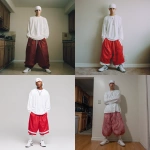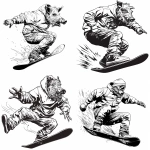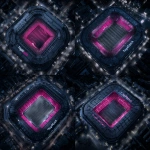Explore the Best AI Image Gallery

Beyond the Brushstrokes: Wearable Tech as a Creative Conduit
The realm of creativity has always been defined by innovation and the relentless pursuit of new mediums. Today, the fusion of technology and art is reaching unprecedented heights, with wearable technology emerging as a powerful catalyst for artistic expression. From interactive installations that respond to body movements to personalized design experiences crafted through augmented reality, wearable tech is blurring the lines between artist and audience, creator and creation.
Wearable Tech: A New Palette for Creative Exploration
Imagine an artist whose brushstrokes are guided by their heart rate, translating emotions into vibrant colors on a digital canvas. This is just one example of how wearable sensors can be integrated into artistic practices, allowing artists to channel physical sensations and biometric data into their work.
- Interactive Installations: Wearable sensors embedded in clothing or accessories can transform art installations into dynamic, responsive experiences. Imagine a sculpture that reacts to the presence of viewers, its colors shifting or sounds evolving based on the collective movement and energy of the audience.
- Personalized Design Experiences: Augmented reality (AR) glasses or contact lenses can overlay digital designs onto physical objects, allowing users to visualize and customize their surroundings in real time. This opens up possibilities for personalized fashion, interior design, and even urban planning.
- Performance Art Amplified: Wearable tech can enhance live performances by integrating sensors into costumes, instruments, or props. Dancers can control lighting effects or sound sequences with their movements, while musicians can experiment with new sonic textures generated by their body movements.
Navigating the Ethical Landscape
As wearable technology becomes increasingly integrated into creative practices, its essential to consider the ethical implications.
- Data Privacy: Wearable sensors collect a wealth of personal data, including biometric information and location tracking. It is crucial to ensure transparency and user consent regarding data collection, storage, and usage.
- Accessibility and Inclusivity: Wearable tech should be designed to be accessible to all individuals, regardless of their physical abilities or socioeconomic status. Efforts should be made to address potential barriers and create equitable opportunities for participation in creative expression.
- Authenticity and Ownership: The use of AI algorithms and generative technologies in art raises questions about authorship and the nature of creativity. It is important to establish clear guidelines and ethical frameworks that acknowledge the contributions of both human artists and technological tools.
Future Horizons: A Convergence of Creativity and Technology
The future of wearable technology in the creative industry holds immense potential. We can expect to see:
- More Seamless Integrations: Wearable devices will become increasingly integrated with other technologies, such as virtual reality (VR), mixed reality (MR), and the metaverse, creating immersive and interactive creative experiences.
- Advanced Sensing Capabilities: Sensors will continue to evolve, becoming more sophisticated in their ability to capture subtle nuances of human movement, emotion, and even thought patterns. This will unlock new artistic possibilities and allow for a deeper connection between artist and audience.
- Personalized Creativity Tools: AI-powered tools will empower individuals to create personalized artworks, music, and designs based on their unique preferences and styles.
As wearable technology continues to evolve, it has the power to democratize creativity, making artistic expression accessible to a wider range of individuals. By embracing these advancements responsibly and ethically, we can unlock a future where the boundaries between technology and art are blurred, giving rise to innovative and inspiring forms of creative expression.

](https://images.ai-img.art/thumbnails/150/3ccc82ef0ad0cc1ab1dfb5b8e6bc37924fcad45dadf41cbd1cb21d19fc7f640a.webp)
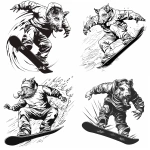



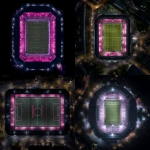
](https://images.ai-img.art/thumbnails/150/69d81ae5ecde297f3c11da78435c5fc00fbac7b00e2c7ccd89d7bbeb014e0541.webp)



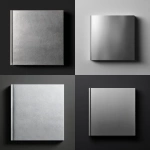
](https://images.ai-img.art/thumbnails/150/738b292720ee21b57673dfb75ad851f4c34d16f5006ae3027ba685feaddb6b04.webp)



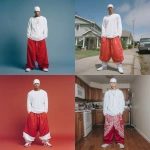

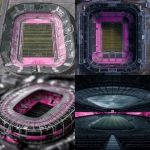
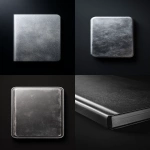


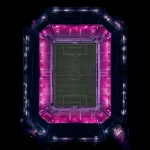
](https://images.ai-img.art/thumbnails/150/807ac97f95d56e8cc7cf714e13299d80bf6bcb5b4d80b77a7f06f30246184943.webp)
](https://images.ai-img.art/thumbnails/150/908bcb9950a44fd4b37d1a84cf00178988cea9507738d7ad4f92707c692461ef.webp)

](https://images.ai-img.art/thumbnails/150/57afc09cc38edf73880f760b7ebe1852c5522c6b4051836717b2e56b6f7f913c.webp)
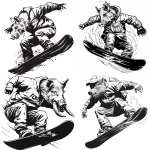
](https://images.ai-img.art/thumbnails/150/83ec831b9fb19e0db5a520b051b9556f3f594b87acc957ffee094a06a565e6f0.webp)

](https://images.ai-img.art/thumbnails/150/05b3252b3f681226a3df9027b069db31c005f91b72257a74367c4102f03a2ba0.webp)







](https://images.ai-img.art/thumbnails/150/fc468fe14407b96489933a55227127071fd5f6c0505be74ca4dcb2f1e2fa3771.webp)
